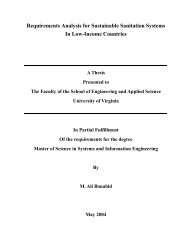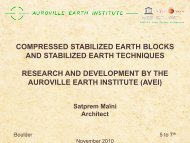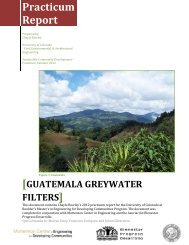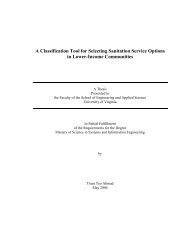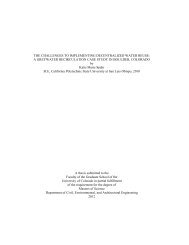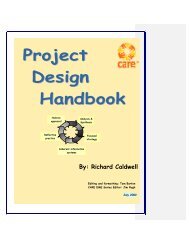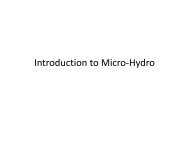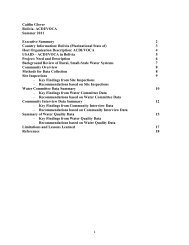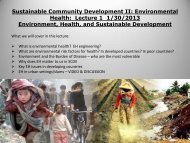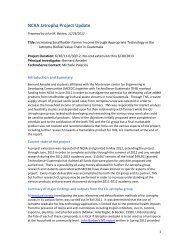SCEBs - University of Colorado Boulder
SCEBs - University of Colorado Boulder
SCEBs - University of Colorado Boulder
You also want an ePaper? Increase the reach of your titles
YUMPU automatically turns print PDFs into web optimized ePapers that Google loves.
1. Introduction<br />
The demand for sustainable building materials at low cost is growing as social,<br />
economic, and environmental issues evolve in today‟s society. Stabilized compressed<br />
earthen block (SCEB) technology <strong>of</strong>fers an alternative to traditional building practices<br />
that is relatively inexpensive, uses local resources, and in some cases, has been found to<br />
last several millennia (ASTM E2392). Although earthen building is not a new concept,<br />
the documentation regarding best practices for SCEB production is limited or<br />
inconsistent. Often soils used in SCEB production are conveniently mined in proximity<br />
to the project site lending to a wide variety <strong>of</strong> soil types and properties from project to<br />
project. The uncertainty behind selecting a suitable soil for SCEB production presents<br />
the need for a systematic approach to implementing and guaranteeing a successful<br />
project. This report emphasizes the importance <strong>of</strong> standardization by: (i) providing a<br />
suggested best practice procedure for selecting suitable soils; (ii) developing a suite <strong>of</strong><br />
material quality tests; and (iii) introducing adapted field testing procedures.<br />
Throughout this report, <strong>SCEBs</strong> refer to blocks that are comprised <strong>of</strong> a mixture <strong>of</strong><br />
angular sand aggregate (40-70%), clayey soil (30-60%), water (~10%), and Portland<br />
cement (5-6%). This predetermined soil mix is added to a block mold and pressed, either<br />
manually or hydraulically, to form a block. Due to the geographic locations <strong>of</strong> the case<br />
studies presented (Southern CO and Southern MT), Portland cement was added to<br />
stabilize the blocks which were used as samples for this report. The addition <strong>of</strong> cement is<br />
intended to minimize any swelling characteristics <strong>of</strong> the clayey soil and to reduce the<br />
amount <strong>of</strong> moisture that the blocks can retain, therefore reducing the effects <strong>of</strong><br />
freeze/thaw cycles experienced in cold climates.



